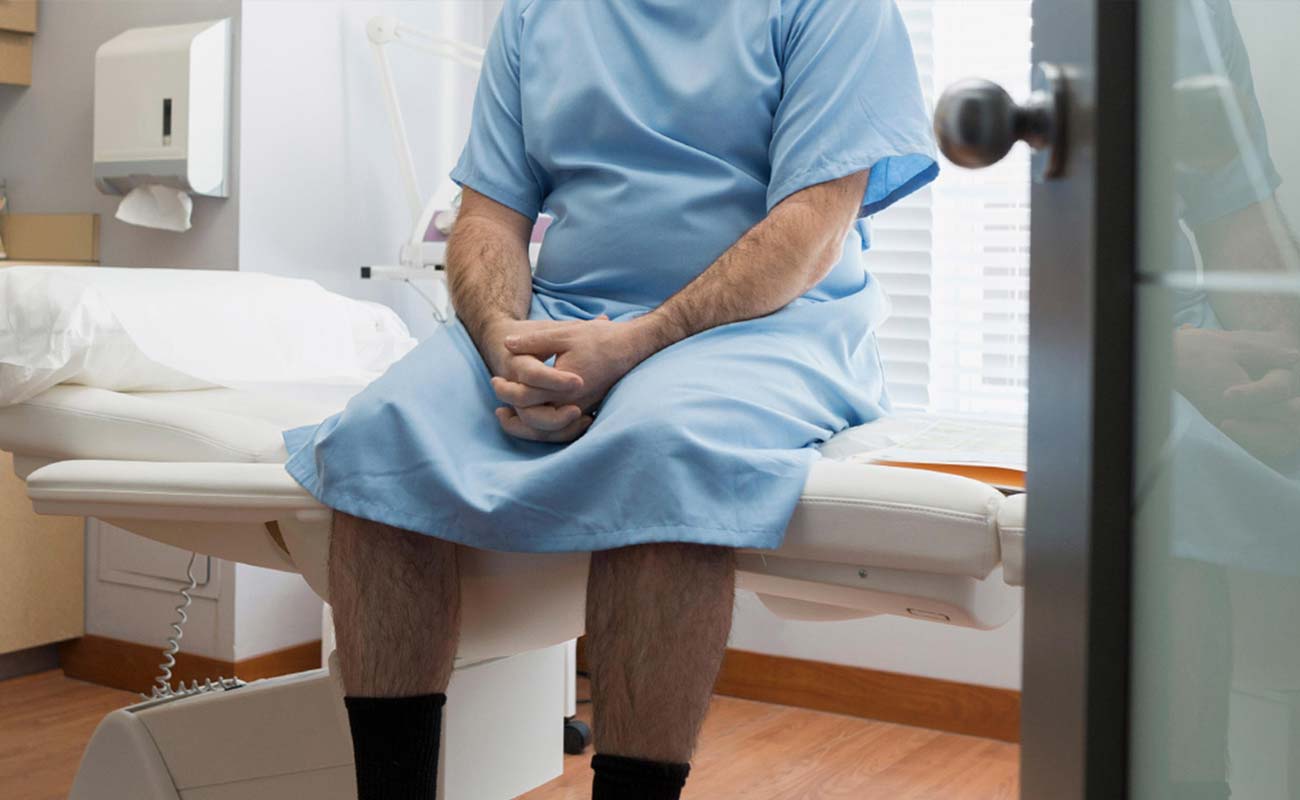The prostate is a gland in the male reproductive system. It makes most of the semen that carries sperm. The walnut-sized gland is located beneath the bladder and surrounds the upper part of the urethra, the tube that carries urine from the bladder.
Prostate cancer is a major health concern for American men. The disease is rare before age 50, and experts believe that most elderly men have traces of it.
Prostate cancer is usually a very slow growing cancer, often causing no symptoms until it is in an advanced stage. Most men with prostate cancer die of other causes, and many never know that they have the disease. But once prostate cancer begins to grow quickly or spreads outside the prostate, it is dangerous.
Urinary symptoms of prostate cancer
Because of the proximity of the prostate gland in relation to the bladder and urethra, prostate cancer may be accompanied by a variety of urinary symptoms. Depending on the size and location, a tumor may press on and constrict the urethra, inhibiting the flow of urine. Some prostate cancer signs related to urination include:
Other prostate cancer signs & symptoms
Prostate cancer may spread (metastasize) to nearby tissues or bones. If the cancer spreads to the spine, it may press on the spinal nerves. Other prostate cancer symptoms include:

Some gene mutations can be passed from generation to generation and are found in all cells in the body. These mutations are inherited. Inherited gene changes cause about 5% to 10% of prostate cancers. Cancer caused by inherited genes is called hereditary cancer. Several inherited mutated genes have been linked to hereditary prostate cancer, including:
RNASEL (formerly HPC1): The normal function of this tumor suppressor gene is to help cells die when something goes wrong inside them. Inherited mutations in this gene might let abnormal cells live longer than they should, which can lead to an increased risk of prostate cancer.
BRCA1 and BRCA2: These tumor suppressor genes normally help repair mistakes in a cell’s DNA (or cause the cell to die if the mistake can’t be fixed). Inherited mutations in these genes more commonly cause breast and ovarian cancer in women. But changes in these genes (especially BRCA2) also account for a small number of prostate cancers.
DNA mismatch repair genes (such as MSH2 and MLH1): These genes normally help fix mistakes (mismatches) in DNA that are made when a cell is preparing to divide into 2 new cells. (Cells must make a new copy of their DNA each time they divide.) Men with inherited mutations in these genes have a condition known as Lynch syndrome (also known as hereditary non-polyposis colorectal cancer, or HNPCC), and are at increased risk of colorectal, prostate, and some other cancers.
HOXB13: This gene is important in the development of the prostate gland. Mutations in this gene have been linked to early-onset prostate cancer (prostate cancer diagnosed at a young age) that runs in some families. Fortunately, this mutation is rare.
Other inherited gene mutations may account for some hereditary prostate cancers, and research is being done to find these genes.
Acquired gene mutations
Some gene mutations happen during a person’s lifetime and are not passed on to children. These changes are found only in cells that come from the original mutated cell. These are called acquired mutations. Most gene mutations related to prostate cancer seem to develop during a man’s life rather than having been inherited.
Every time a cell prepares to divide into 2 new cells, it must copy its DNA. This process is not perfect, and sometimes errors occur, leaving defective DNA in the new cell. It’s not clear how often these DNA changes might be random events, and how often they are influenced by other factors (such as diet, hormone levels, etc.). In general, the more quickly prostate cells grow and divide, the more chances there are for mutations to occur. Therefore, anything that speeds up this process may make prostate cancer more likely.
For example, androgens (male hormones), such as testosterone, promote prostate cell growth. Having higher levels of androgens might contribute to prostate cancer risk in some men.
Some research has found that men with high levels of another hormone, insulin-like growth factor-1 (IGF-1), are more likely to get prostate cancer. However, other studies have not found such a link. Further research is needed to make sense of these findings.
As mentioned in Prostate Cancer Risk Factors, some studies have found that inflammation in the prostate may contribute to prostate cancer. One theory is that inflammation might lead to cell DNA damage, which may contribute to a normal cell becoming a cancer cell. More research is needed in this area.
Exposure to radiation or cancer-causing chemicals can cause DNA mutations in many organs, but these factors have not been proven to be important causes of mutations in prostate cells.
Whether to test healthy men with no symptoms for prostate cancer is controversial. Medical organizations don't agree on the issue of screening and whether it has benefits.
Some medical organizations recommend men consider prostate cancer screening in their 50s, or sooner for men who have risk factors for prostate cancer. Other organizations advise against screening.
Discuss your particular situation and the benefits and risks of screening with your doctor. Together, you can decide whether prostate cancer screening is right for you.
Prostate screening tests might include:
PSA testing combined with DRE helps identify prostate cancers at their earliest stages, but studies have disagreed whether these tests reduce the risk of dying of prostate cancer. For that reason, there is debate surrounding prostate cancer screening.
If an abnormality is detected on a DRE or PSA test, your doctor may recommend tests to determine whether you have prostate cancer, such as:
When a biopsy confirms the presence of cancer, the next step is to determine the level of aggressiveness (grade) of the cancer cells. In a laboratory, a pathologist examines a sample of your cancer to determine how much cancer cells differ from the healthy cells. A higher grade indicates a more aggressive cancer that is more likely to spread quickly.
The most common scale used to evaluate the grade of prostate cancer cells is called a Gleason score. Scoring combines two numbers and can range from 2 (nonaggressive cancer) to 10 (very aggressive cancer).
Once a prostate cancer diagnosis has been made, your doctor works to determine the extent (stage) of the cancer. If your doctor suspects your cancer may have spread beyond your prostate, imaging tests such as these may be recommended:
Not every person should have every test. Your doctor will help determine which tests are best for your individual case.
Once testing is complete, your doctor assigns your cancer a stage. This helps determine your treatment options. The prostate cancer stages are:
Your prostate cancer treatment options depend on several factors, such as how fast your cancer is growing, how much it has spread and your overall health, as well as the benefits and the potential side effects of the treatment.
For men diagnosed with very early-stage prostate cancer, treatment may not be necessary right away. Some men may never need treatment. Instead, doctors sometimes recommend active surveillance.
In active surveillance, regular follow-up blood tests, rectal exams and possibly biopsies may be performed to monitor progression of your cancer. If tests show your cancer is progressing, you may opt for a prostate cancer treatment such as surgery or radiation.
Active surveillance may be an option for cancer that isn't causing symptoms, is expected to grow very slowly and is confined to a small area of the prostate. Active surveillance may also be considered for a man who has another serious health condition or an advanced age that makes cancer treatment more difficult.
Active surveillance carries a risk that the cancer may grow and spread between checkups, making it less likely to be cured.
Radiation therapy uses high-powered energy to kill cancer cells. Prostate cancer radiation therapy can be delivered in two ways:
Side effects of radiation therapy can include painful urination, frequent urination and urgent urination, as well as rectal symptoms, such as loose stools or pain when passing stools. Erectile dysfunction can also occur.
Hormone therapy is treatment to stop your body from producing the male hormone testosterone. Prostate cancer cells rely on testosterone to help them grow. Cutting off the supply of hormones may cause cancer cells to die or to grow more slowly.
Hormone therapy options include:
Hormone therapy is used in men with advanced prostate cancer to shrink the cancer and slow the growth of tumors. In men with early-stage prostate cancer, hormone therapy may be used to shrink tumors before radiation therapy. This can make it more likely that radiation therapy will be successful.
Side effects of hormone therapy may include erectile dysfunction, hot flashes, loss of bone mass, reduced sex drive and weight gain.
Surgery for prostate cancer involves removing the prostate gland (radical prostatectomy), some surrounding tissue and a few lymph nodes. Ways the radical prostatectomy procedure can be performed include:
Discuss with your doctor which type of surgery is best for your specific situation.
Radical prostatectomy carries a risk of urinary incontinence and erectile dysfunction. Ask your doctor to explain the risks you may face based on your situation, the type of procedure you select, your age, your body type and your overall health.
Cryosurgery or cryoablation involves freezing tissue to kill cancer cells.
During cryosurgery for prostate cancer, small needles are inserted in the prostate using ultrasound images as guidance. A very cold gas is placed in the needles, which causes the surrounding tissue to freeze. A second gas is then placed in the needles to reheat the tissue. The cycles of freezing and thawing kill the cancer cells and some surrounding healthy tissue.
Initial attempts to use cryosurgery for prostate cancer resulted in high complication rates and unacceptable side effects. However, newer technologies have lowered complication rates, improved cancer control and made the procedure easier to tolerate. Cryosurgery may be an option for men who haven't been helped by radiation therapy.

Chemotherapy uses drugs to kill rapidly growing cells, including cancer cells. Chemotherapy can be administered through a vein in your arm, in pill form or both.
Chemotherapy may be a treatment option for men with prostate cancer that has spread to distant areas of their bodies. Chemotherapy may also be an option for cancers that don't respond to hormone therapy.
Biological therapy (immunotherapy) uses your body's immune system to fight cancer cells. One type of biological therapy called sipuleucel-T (Provenge) has been developed to treat advanced, recurrent prostate cancer.
This treatment takes some of your own immune cells, genetically engineers them in a laboratory to fight prostate cancer, and injects the cells back into your body through a vein. Some men do respond to this therapy with some improvement in their cancer, but the treatment is very expensive and requires multiple treatments.
Sources: webmd, pcf.org, mayoclinic.org, cancercenter, cancer.org
Submit Comment